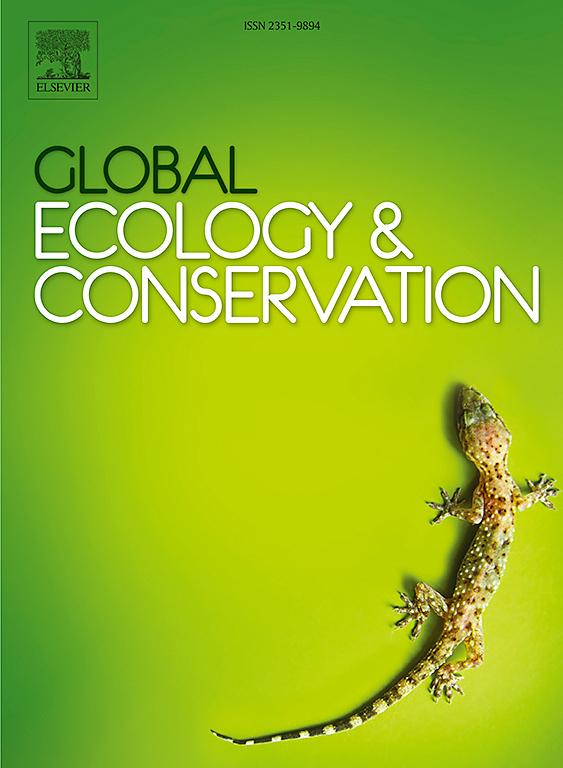Effects of tourism on seasonal movements and fine-scale habitat selection of African lions and spotted hyenas in Etosha National Park, Namibia
IF 3.5
2区 环境科学与生态学
Q1 BIODIVERSITY CONSERVATION
引用次数: 0
Abstract
Understanding the drivers of habitat selection for apex predators, such as African lions (Panthera leo) and spotted hyenas (Crocuta crocuta), is a vital component of conservation efforts. Large carnivores are especially vulnerable to anthropogenic pressures, which are increasing in areas of Sub-Saharan Africa. As wildlife-based tourism increases human-wildlife interactions, it is crucial to better understand predator habitat selection to inform conservation strategies. In this study, we used GPS collar data from 14 lions and nine hyenas tracked between 2016 and 2024 in Etosha National Park, Namibia to develop step selection functions to determine how roads, waterholes, and vegetation influenced habitat selection during periods of high and low tourism. Our results show that within a protected area popular for tourism, lion and hyena habitat selection is influenced by environmental and anthropogenic factors during both day and night. However, the distribution and availability of habitat and vegetation was a more important driver of habitat selection than anthropogenic factors in our study system. In particular, during both seasons water availability was a main driver of habitat selection for lions. Lions and hyenas selected for areas near roads with less tourism activity, which may indicate they avoid certain areas to minimize interactions with humans. Vegetation density influenced selection by both species, with lions selecting for areas with low vegetation density and hyenas selected for areas with high vegetation density in both seasons. These results contribute to our understanding of lion and hyena habitat selection as human activities continue to increase across the globe.
旅游业对纳米比亚埃托沙国家公园非洲狮和斑点鬣狗季节性迁徙和精细生境选择的影响
了解非洲狮(Panthera leo)和斑点鬣狗(Crocuta Crocuta)等顶级捕食者栖息地选择的驱动因素,是保护工作的重要组成部分。在撒哈拉以南非洲地区,大型食肉动物尤其容易受到人为压力的影响。随着以野生动物为基础的旅游增加了人类与野生动物的互动,更好地了解捕食者栖息地选择对保护策略至关重要。在这项研究中,我们使用了2016年至2024年间在纳米比亚埃托沙国家公园追踪的14只狮子和9只鬣狗的GPS项圈数据,开发了阶梯选择功能,以确定道路、水坑和植被在旅游高峰和低谷期间如何影响栖息地选择。研究结果表明,在旅游保护区内,狮子和鬣狗的栖息地选择在白天和夜间都受到环境和人为因素的影响。然而,在我们的研究系统中,生境和植被的分布和可用性是比人为因素更重要的生境选择驱动因素。特别是,在这两个季节,水的可用性是狮子栖息地选择的主要驱动因素。狮子和鬣狗选择靠近旅游活动较少的道路的区域,这可能表明它们避开某些区域以尽量减少与人类的互动。植被密度影响两种物种的选择,在两个季节中,狮子选择低植被密度的地区,鬣狗选择高植被密度的地区。这些结果有助于我们理解随着人类活动在全球范围内的不断增加,狮子和鬣狗的栖息地选择。
本文章由计算机程序翻译,如有差异,请以英文原文为准。
求助全文
约1分钟内获得全文
求助全文
来源期刊

Global Ecology and Conservation
Agricultural and Biological Sciences-Ecology, Evolution, Behavior and Systematics
CiteScore
8.10
自引率
5.00%
发文量
346
审稿时长
83 days
期刊介绍:
Global Ecology and Conservation is a peer-reviewed, open-access journal covering all sub-disciplines of ecological and conservation science: from theory to practice, from molecules to ecosystems, from regional to global. The fields covered include: organismal, population, community, and ecosystem ecology; physiological, evolutionary, and behavioral ecology; and conservation science.
 求助内容:
求助内容: 应助结果提醒方式:
应助结果提醒方式:


